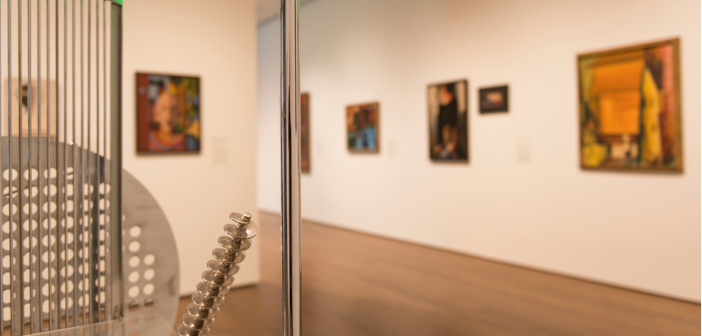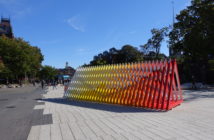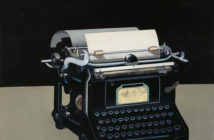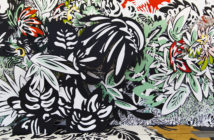The remaining brick façade from 1927, facing Harvard Yard, suggests an institution steeped in tradition. From the front, one expects to step inside and see art by dead white men, displayed according to national styles and chronology. The backside, however, explodes the brick structure with a boxy grey addition topped with a pyramid of glass. The dichotomy between order and innovation that plays out in the architecture continues inside the galleries. While the museum has little African, pre-Columbian, or Native American art, and few modern or contemporary pieces from outside the United States and Western Europe, the re-installation of the collections nevertheless succeeds in challenging existing narratives of art production over the longue durée.
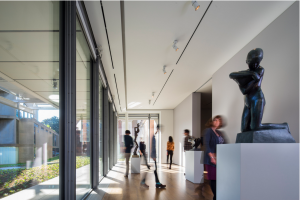
A gallery at the new Harvard Art Museums, with sculptures from the collection of the Busch-Reisinger Museum. Photo: © Nic Lehoux.
After being closed for six years, Harvard University’s three museums, The Fogg, The Arthur M. Sackler, and The Busch-Reisinger, have been reinstalled under one roof with new classrooms, study spaces, display cases, and conservation labs designed by the Renzo Piano Building Workshop. The renovated, unified, and reinstalled building, with a price tag of $350 million and forty-percent more gallery space, opened in November 2014. The original structure was largely gutted, save for an interior Renaissance revival courtyard, allowing for an airy atrium soaring up to a fifth floor "lightbox gallery" where visitors can explore the collection with a sophisticated digital interface.
The curators used the past six years to review the immense 250,000-object collection and consider how it can be made most pedagogical to students and visitors. One of the best examples of the adventurousness with which the curators undertook this task is the intrusion of Louise Bourgeois’ rough and choppy cube of pink marble, Nature Study (1986), in a gallery otherwise devoted to Classical sculpture. Having finished with the modern and contemporary galleries on the ground floor, one is surprised to meet Ms. Bourgeois among antiquities on the third floor. The ancient sculptures are blemish-free, muscular, stoic, and convey the notion of perfection as it was conceived by the progenitors of Western civilization. Bourgeois’ stubby, jagged, purposely unfinished-looking sculpture forces one to consider the way in which the ancient works also fall outside conventional notions of the ideal. They are, after all, Roman copies of Greek sculptures, and stand before us today missing limbs and facial features. The curators have positioned Bourgeois’ work among the antiquities to show that artworks, from ancient to contemporary, are constantly in a state of becoming, that their meaning is never fixed.
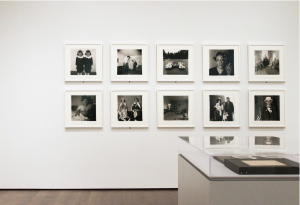
A gallery at the new Harvard Art Museums, with photographs from the collection of the Fogg Museum. Photo: Steven Waldron.
In 1911, in the context of the Harvard Art Museums’ first exhibition devoted to a living artist, the museum director reminded his colleagues that, "In the past, the policy of the Fogg museum has been to exhibit the work of men who are dead." More than a century later, the institution continues to navigate its relationship with the contemporary. Despite the modern and contemporary galleries’ place of pride on the ground floor, surprisingly little of the total 204,000 square feet of the new building is devoted to art made during the lifetime of the students who the museum is supposed to serve. Only a small room with works by Kerry James Marshall, Kiki Smith, Gary Schneider, Mona Hatoum, Rosemarie Trockel, Zhang Xiaogang, Robert Gober, and Doris Salcedo begins to nod to the transnational, queer, and non-Western artistic practices of recent years. The curatorial intervention in the history of modern and contemporary art, then, is not about what is displayed but rather how.
When one accepts the museum’s invitation to look slowly and carefully, surprises abound. Galleries devoted to postwar art move away from the hegemonic narrative of the New York School that dominates in most American museums of this caliber. By showing Joan Miró and Alexander Calder in the postwar gallery, the curators demonstrate Abstract Expressionism’s debt to Surrealism. Frank Stella’s pistachio and carmine painting, Red River Valley (1958), has light damage along the top that would prevent curators at other museums from showing it but because Harvard’s galleries are dedicated to learning, this example is used to show the materiality of art in its true state of flux. That artworks, like artists, change over time is also the lesson of the exhibition, "Mark Rothko’s Harvard Murals," which restores the colors of damaged works by way of digital projection. This feat of science and technology demonstrates the state-of-the-field in conservation science, although step too close to the paintings and your shadow will shatter the illusion.

Frank Stella, Red River Valley, 1958. Oil on canvas. Harvard Art Museums/Fogg Museum, Gift of Lawrence Rubin, 1973.135. © Frank Stella / Artists Rights Society (ARS), New York. Photo © President and Fellows of Harvard College.
One way to view a museum is to look at its "holes," and every collection has them. For years, Harvard considering building a museum for modern and contemporary art in Allston but the University seems to have indefinitely shelved plans for that campus. Helen Molesworth’s short-lived tenure at the museum from 2007-10 was a turning point for the institution, which had never previously had a full curator of contemporary art. The recent focus on modern and contemporary art can be partially attributed to a major gift in 2008 from Emily Rauh Pulitzer and Joseph Pulitzer, Jr., which included a fund for modern and contemporary art that supported the current exhibition on the contemporary German artist, Rebecca Horn. As the Harvard Art Museums increasingly embrace the contemporary, it is inevitable that their collection of non-Western art will grow in kind.
There will be about seventy rotations of object-groups over the next two years, much more so than one normally sees in a permanent collection. This is a major commitment of staff hours and energies, particularly because the museum is now open seven days a week and so the works must be switched out overnight. Given the rapidity with which the collection is cycling through the galleries, if you don’t like what you see, come back in a few months.

